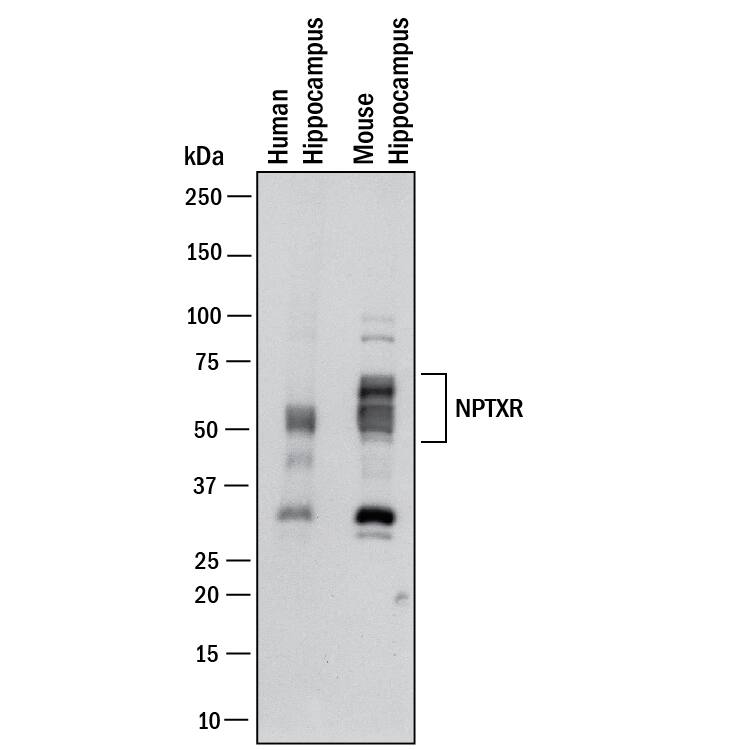Human/Mouse Neuronal Pentraxin R/NPTXR Antibody
R&D Systems, part of Bio-Techne | Catalog # MAB4414

Key Product Details
Species Reactivity
Applications
Label
Antibody Source
Product Specifications
Immunogen
Ala24-Ala500
Accession # O95502
Specificity
Clonality
Host
Isotype
Scientific Data Images for Human/Mouse Neuronal Pentraxin R/NPTXR Antibody
Detection of Human and Mouse Neuronal Pentraxin R/NPTXR by Western Blot.
Western blot shows lysates of human brain (hippocampus) and mouse brain (hippocampus). PVDF membrane was probed with 2 µg/mL of Mouse Anti-Human/Mouse Neuronal Pentraxin R/NPTXR Monoclonal Antibody (Catalog # MAB4414) followed by HRP-conjugated Anti-Mouse IgG Secondary Antibody (HAF018). A specific band was detected for Neuronal Pentraxin R/NPTXR at approximately 50-70 kDa (as indicated). This experiment was conducted under reducing conditions and using Western Blot Buffer Group 1.Neuronal Pentraxin R/NPTXR in Human Brain (Cortex).
Neuronal Pentraxin R/NPTXR was detected in immersion fixed paraffin-embedded sections of human brain (cortex) using Mouse Anti-Human/Mouse Neuronal Pentraxin R/NPTXR Monoclonal Antibody (Catalog # MAB4414) at 5 µg/mL for 1 hour at room temperature followed by incubation with the Anti-Mouse IgG VisUCyte™ HRP Polymer Antibody (VC001). Before incubation with the primary antibody, tissue was subjected to heat-induced epitope retrieval using Antigen Retrieval Reagent-Basic (CTS013). Tissue was stained using DAB (brown) and counterstained with hematoxylin (blue). Specific staining was localized to neuronal cell bodies and processes. Staining was performed using our protocol for IHC Staining with VisUCyte HRP Polymer Detection Reagents.Applications for Human/Mouse Neuronal Pentraxin R/NPTXR Antibody
Immunohistochemistry
Sample: Immersion fixed paraffin-embedded sections of human brain (cortex)
Western Blot
Sample: Human brain (hippocampus) and mouse brain (hippocampus)
Formulation, Preparation, and Storage
Purification
Reconstitution
Formulation
Shipping
Stability & Storage
- 12 months from date of receipt, -20 to -70 °C as supplied.
- 1 month, 2 to 8 °C under sterile conditions after reconstitution.
- 6 months, -20 to -70 °C under sterile conditions after reconstitution.
Background: Neuronal Pentraxin R/NPTXR
The Neuronal Pentraxin Receptor (NPTXR; also called NPR) is a 55‑65 kDa, type II transmembrane glycoprotein within the Pentraxin family. NPTXR is co‑expressed and forms heteromultimers with the related, secreted proteins NPTX1 and NPTX2/NARP (1, 2). Human NPTXR is a 500 amino acid (aa) protein that includes a 477 aa extracellular domain (ECD) with one calcium-binding Pentraxin domain. The human NPTXR ECD shares 88% and 89% aa sequence identity with mouse and rat NPTXR, respectively. A 62 kDa soluble form is generated by TACE/ADAM17 proteolytic cleavage C-terminal to the transmembrane segment (3). Soluble forms of 55 kDa and 45 kDa have also been reported (2, 3). NPTXR is expressed on cerebellar Purkinje and granule cells, and hippocampal neurons of the CA1, CA3 and dentate gyrus regions (1). It is enriched on axonal membranes at excitatory synapses where, with NPTX1, it recruits the GluR4 subunit of AMPA-type glutamate receptors (AMPAR) to promote synaptogenesis (3, 4). Synaptic activity stimulates mGluR1 or mGluR5 receptors, which then activate TACE, causing release of the NPTXR heteromultimer complex from the membrane (3). NPTX1/2 within the complex mediate binding AMPAR, while the soluble (but not transmembrane) form of NPTXR within the complex mediates AMPAR endocytosis and mGluR1/5‑mediated long-term depression (3). NPTXR is reported to be increased in cerebrospinal fluid or serum of Alzheimer’s disease patients as compared to controls (5). Aberrant expression of transmembrane NPTXR has also been reported in small-cell lung cancers (SCLC; 6).
References
- Dodds, D.C. et al. (1997) J. Biol. Chem. 272:21488.
- Kirkpatrick, L.L. et al. (2000) J. Biol. Chem. 275:17786.
- Cho, R.W. et al. (2008) Neuron 57:858.
- Sia, G.M. et al. (2007) Neuron 55:87.
- Yin, G.N. et al. (2009) Brain Res. 1265:158.
- Poulsen, T.T. et al. (2005) Lung Cancer 50:329.
Alternate Names
Gene Symbol
UniProt
Additional Neuronal Pentraxin R/NPTXR Products
Product Documents for Human/Mouse Neuronal Pentraxin R/NPTXR Antibody
Product Specific Notices for Human/Mouse Neuronal Pentraxin R/NPTXR Antibody
For research use only

